University of Southampton
 | |
Latin: Universitas Sotoniensis | |
| Motto | Strenuis Ardua Cedunt (Latin) |
|---|---|
Motto in English | The Heights Yield to Endeavour[1] |
| Type | research university |
| Established | 1952 – gained university status by royal charter 1902 – Hartley University College 1862 – Hartley Institution |
| Endowment | £12.9 million (as of 31 July 2017)[2] |
| Budget | £584.0 million (2016–17)[2] |
| Chancellor | Dame Helen Alexander[3] |
| Vice-Chancellor | Sir Christopher Snowden |
| Visitor | The Lord President of the Council (ex officio) |
Administrative staff | 5,001 |
| Students | 25,180 (2016/17)[4] |
| Undergraduates | 17,535 (2016/17)[4] |
| Postgraduates | 7,650 (2016/17)[4] |
| Location | Southampton , United Kingdom |
| Campus | City Campus |
| Colours | Navy blue, light sea green and dark red |
| Affiliations | Russell Group ACU EUA WUN Universities UK SES SETsquared |
| Website | https://www.southampton.ac.uk/ |
 | |
The University of Southampton (abbreviated as Soton in post-nominal letters[5]) is a research university located in Southampton, England. The university's origins date back to the founding of the Hartley Institution in 1862. In 1902, the Institution developed into the Hartley University College, awarding degrees from the University of London.[6] On 29 April 1952, the institution was granted full university status, allowing it to award its own degrees. Southampton is a founding member of the Russell Group of research-intensive universities in Britain. In the most recent Research Excellence Framework the university was ranked 18th in the United Kingdom for average quality of research submitted, 11th for research power and 8th for research intensity.[7]
The university has seven teaching campuses.[8] The main campus is located in the Highfield area of Southampton and is supplemented by four other campuses within the city: Avenue Campus housing the Faculty of Humanities, the National Oceanography Centre housing courses in Ocean and Earth Sciences, Southampton General Hospital offering courses in Medicine and Health Sciences,[8] and Boldrewood Campus an engineering and maritime technology campus housing also the university's strategic ally Lloyd's Register.[9] In addition, the university operates a School of Art based in nearby Winchester[10] and an international branch in Malaysia offering courses in Engineering.[8] Each campus is equipped with its own library facilities.[11]
The University of Southampton currently has 17,535 undergraduate and 7,650 postgraduate students, making it the largest university by higher education students in the South East region. The University of Southampton Students' Union, provides support, representation and social activities for the students ranging from involvement in the Union's four media outlets to any of the 200 affiliated societies and 80 sports.[citation needed] The university owns and operates a sports ground at nearby Wide Lane for use by students and also operates a sports centre on the main campus.[12]
Contents
1 History
1.1 Hartley Institution
1.2 University College
1.3 University
1.4 Research university
2 Campuses
2.1 Highfield Campus
2.2 Avenue Campus
2.3 National Oceanography Centre, Southampton
2.4 University Hospital Southampton (UHS)
2.5 Winchester School of Art
2.6 Malaysia Campus
2.7 Other sites
2.7.1 Boldrewood Campus
2.7.2 Science Park
2.7.3 Centre for Cancer Immunology
2.8 Transport Links
3 Organisation
3.1 Governance
3.2 Faculties
3.3 Affiliations
4 Academic profile
4.1 Courses and subjects
4.2 Admissions
4.3 Rankings and reputation
4.4 Subject rankings
4.5 Research
4.5.1 Research Institutes
4.5.2 Institute of Sound and Vibration Research
4.6 EPrints
5 Student life
5.1 Students' Union
5.2 Halls of Residence
5.3 Libraries
5.4 Arts
5.5 Healthcare
5.6 Sports
5.6.1 Mustangs Baseball Club
5.6.2 National student championships
6 Notable people
6.1 Academics
7 See also
8 References
9 Further reading
10 External links
History
Hartley Institution
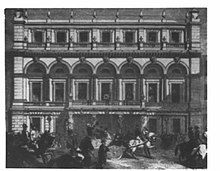
The arrival of Prime Minister Lord Palmerston for the opening of the Hartley Institute on 15 October 1862
The University of Southampton has its origin as the Hartley Institution which was formed in 1862 from a benefaction by Henry Robinson Hartley (1777–1850). Hartley had inherited a fortune from two generations of successful wine merchants.[13] At his death in 1850, he left a bequest of £103,000 to the Southampton Corporation for the study and advancement of the sciences in his property on Southampton's High Street, in the city centre.
| “ | ...employ the interest, dividends and annual proceeds in such a manner as best promote the study and advancement of the sciences of Natural History, Astronomy, Antiquities, Classical and Oriental Literature in the town, such as by forming a Public Library, Botanic Gardens, Observatory, and collections of objects with the above sciences.[14] | ” |
— Bequest to the Corporation of Southampton of Henry Robertson Hartley estate. | ||
Hartley was an eccentric straggler, who had little liking of the new age docks and railways in Southampton.[15] He did not desire to create a college for many (as formed at similar time in other English industrial towns and commercial ports) but a cultural centre for Southampton's intellectual elite.[15] After lengthy legal challenges to the Bequest, and a public debate as to how best interpret the language of his Will, the Southampton Corporation choose to create the Institute (rather than a more widely accessible college, that some public figures had lobbied for).
On 15 October 1862, the Hartley Institute was opened by the Prime Minister Lord Palmerston in a major civic occasion which exceeded in splendor anything that anyone in the town could remember.[16] After initial years of financial struggle, the Hartley Institute became the Hartley College in 1883. This move was followed by increasing numbers of students, teaching staff, an expansion of the facilities and registered lodgings for students.
University College
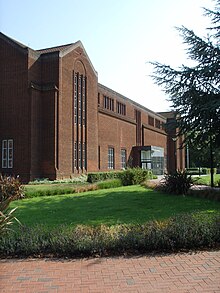
Front of the Hartley Library, constructed in the 1930s after the move to Highfield Campus, with the support of private donors.
In 1902, the Hartley College became the Hartley University college, a degree awarding branch of the University of London. This was after inspection of the teaching and finances by the University College Grants Committee,[17] and donations from Council members (including William Darwin the then Treasurer). An increase in student numbers in the following years motivated fund raising efforts to move the college to greenfield land around Back Lane (now University Road) in the Highfield area of Southampton. On 20 June 1914, Viscount Haldane opened the new site of the renamed Southampton University College. However, the outbreak of the First World War six weeks later meant no lectures could take place there, as the buildings were handed over by the college authorities for use as a military hospital. To cope with the volume of casualties, wooden huts were erected at the rear of the building. These were donated to university by the War Office after the end of fighting, in time for the transfer from the high street premises in 1920. At this time, Highfield Hall, a former country house and overlooking Southampton Common,[18] for which a lease had earlier been secured, commenced use as a halls of residence for female students. South Hill, on what is now the Glen Eyre Halls Complex was also acquired, along with South Stoneham House to house male students.
Further expansion through the 1920s and 1930s was made possible through private donors, such as the two daughters of Edward Turner Sims for the construction of the university library, and from the people of Southampton, enabling new buildings on both sides of University Road. During World War II the university suffered damage in the Southampton Blitz with bombs landing on the campus and its halls of residence.[19] The college decided against evacuation, instead expanding its Engineering Department, School of Navigation and developing a new School of Radio Telegraphy.[19] Halls of residence were also used to house Polish, French and American troops.[19] After the war, departments such as Electronics grew under the influence of Erich Zepler and the Institute of Sound and Vibration was established.
University
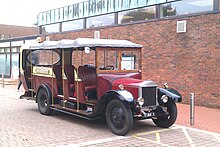
Toast rack, a 1929 Dennis GL that has been owned by the University of Southampton Engineering Society since 1958.
On 29 April 1952, Queen Elizabeth II granted the University of Southampton a Royal Charter, the first to be given to a university during her reign, which enabled it to award degrees.[20] Six faculties were created: Arts, Science, Engineering, Economics, Education and Law. The first University of Southampton degrees were awarded on 4 July 1953, following the appointment of the Duke of Wellington as Chancellor of the university. Student and staff numbers grew throughout the next couple of decades as a response to the Robbins Report. The campus also grew significantly, when in July 1961 the university was given the approval to acquire some 200 houses on or near the campus by the Borough Council.[21] In addition, more faculties and departments were founded, including Medicine and Oceanography (despite the discouragement of Sir John Wolfenden, the chairman of the University Grants Committee).[21] Student accommodation was expanded throughout the 1960s and 1970s with the acquisition of Chilworth manor and new buildings at the Glen Eyre and Montefiore complexes.
In 1987, a crisis developed when the University Grants Committee announced, as part of nationwide cutbacks, a series of reductions in the funding of the university.[22] To eliminate the expected losses, the budgets and deficits subcommittee proposed reducing staff numbers. This proposal was met with demonstrations on campus and was later reworked (to reduce the redundancies and reallocate the reductions in faculties funding) after being rejected by the university Senate.[22]
By the mid-1980s through to the 1990s, the university looked to expand with new buildings on the Highfield campus, developing the Chilworth Manor site into a science park and conference venue, opening the National Oceanography Centre at a dockside location and purchasing new land from the City Council for the Arts Faculty and sports fields (at Avenue Campus and Wide Lane, respectively).[citation needed]
Research university
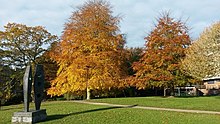
The Gardens on the west half of Highfield Campus were landscaped by Basil Spence and feature artwork by Barbara Hepworth.
Under the leadership of then Vice-Chancellor, Sir Howard Newby the university became more focused in encouraging and investment in more and better quality research.[23]In the mid-1990s, the university gained two new campuses, as the Winchester School of Art and La Sainte Union College became part of the university.[citation needed] A new school for Nursing and Midwifery was also created and went on to provide training for NHS professionals in central-southern England. This involved a huge increase in student numbers and the establishment of sub-campuses in Basingstoke, Winchester, Portsmouth and Newport, Isle of Wight.[23]
In the autumn of 1997, the university experienced Britain's worst outbreak of meningitis, with the death of three students.[24] The university responded to the crisis by organising a mass vaccination programme, and later took the ground-breaking decision to offer all new students vaccinations.[23]
The university celebrated its Golden Jubilee on 22 January 2002. By this time, Southampton had research income that represented over half of the total income,[23]which remains one of the highest proportions of income derived from research activities of British Universities.[citation needed] In recent years a number of new landmark buildings have been added as part of the estates development. New constructions on the main campus include the Jubilee Sports Complex in 2004,[25][26] the EEE (ECS, Education and Entrance) building in 2007,[27][28][29] the new Mountbatten building in 2008 housing the School of Electronics and Computer Science[30][31] following a fire[32][33] and the Life Sciences building in 2010.[34][35][36] In addition, the Hartley Library and Student Services Centre were both extended and redesigned in 2005[37][38][39] and the Students' Union was also extended in 2002.[40][41] Other constructions include the Archaeology building on Avenue Campus in 2006[42][43] and the Institute of Development Sciences building at Southampton General Hospital in 2007.[44] The university has also significantly redeveloped its Boldrewood Campus which is home to part of the engineering faculty and to Lloyd's Register's Global Technology Centre.[45]
The university joined The Science and Engineering South Consortium (SES-5) on 9 May 2013. the SES-5 was created to pool the collective insights and resources of the University of Oxford, University of Cambridge, Imperial College London and University College London to innovate and explore new ideas through collaboration whilst providing efficiencies of scale and shared utilisation of facilities. This is the most powerful cluster of research intensive universities in the UK and the new consortium is to become one of the world's leading hubs for science and engineering research.[46]
Campuses
The university has seven educational campuses – five in Southampton, one in Winchester,[47] and one international branch in Malaysia. The university also operates a science park nearby.[citation needed]The university also owns sports facilities and halls of residences on a variety of other nearby sites.[citation needed]
Highfield Campus
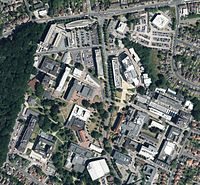
Aerial view of the Highfield Campus
The university's main campus is located in the residential area of Highfield. Opened on 20 June 1914, the site was initially used as a military hospital during World War I. The campus grew gradually, mainly consisting of detailed red brick buildings (such as the Hartley library and West building of the Students' Union) designed by Sir Giles Gilbert Scott.[48] In 1956, Sir Basil Spence was commissioned to prepare a masterplan of the campus for the foreseeable future.[49] This included incorporating the University Road, that split the 59-acre (24 ha) campus in two and the quarry of Sir Sidney Kimber's brickyard that itself was split by a stream. Unable to remove the road and the private houses along it, Spence designed many of the buildings facing away from it, using contemporary designs working in concrete, glass and mosaic.[49] During recent decades, new buildings were added that contravened the master plan of Spence, such as the Synthetic Chemistry Building and Mountbatten Building (the latter of which was destroyed by fire in 2005).
A new masterplan for the Highfield campus was drawn up in 1998 by Rick Mather, who proposed that the University Road should become a tree-lined boulevard backed by white-rendered buildings. He also contributed some of the newer buildings such as the Zepler and Gower Buildings. In 1991, the Highfield Planning Group was formed within the university under the chairmanship of Tim Holt. This led to the development of new buildings such as the Jubilee Sports Hall, Student Services Building and the Institute of Sound and Vibration Research. In addition, existing buildings, such as the Hartley Library, were extensively renovated and extended.[citation needed]
Avenue Campus
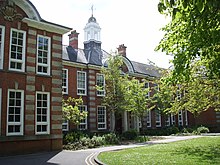
Avenue Campus
Avenue Campus is currently home to the Faculty of Humanities, with the exception of Music, and is located a short distance away from the main Highfield campus. The site previously housed the Southampton Tramsheds and Richard Taunton's College, of which the existing building still stands on the site. It was purchased by the university from Southampton City Council for £2 million in December 1993[23] so that the university could expand – planning regulations meant that excess land on the Highfield campus couldn't be built on and had to be reserved for future car parking spaces. The car parking spaces have now been built.[50] The departments moved onto the campus in 1996.[51] The campus consists of the original Tauntons building from the early 20th century but redeveloped with a glass-fronted courtyard and extension and a new Archaeology building built in 2006 costing £2.7 million.[52]
National Oceanography Centre, Southampton
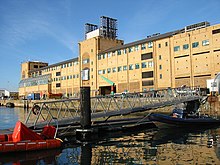
National Oceanography Centre, Southampton
The National Oceanography Centre, Southampton (NOCS) is located in Southampton Docks some three miles south of the main university campus. The campus is home of the university's Ocean and Earth Sciences department and is also a campus of the Natural Environment Research Council's research institute, the National Oceanography Centre.[53] Five of the National Oceanography Centre's research divisions are based on the campus.[53]
Planning of the campus began in 1989 and was completed in 1994 due to cuts and uncertainties whether a national research centre could be successfully integrated with a university.[54]It was opened in 1996 by the Duke of Edinburgh. The campus was also the base for the NERC purpose-built research vessels RRS James Cook and until recently the RRS Discovery and the RRS Charles Darwin.[citation needed]
University Hospital Southampton (UHS)
The university maintains a presence at Southampton General in partnership with the NHS trust operating the hospital. It is home to some operations of the Faculty of Medicine and the Faculty of Health Sciences, although these two faculties have bases on Highfield campus. As a teaching hospital, it is used by a range of undergraduate and postgraduate medical students, research academics and clinicians.[citation needed]
The university's involvement began in 1971, when it became the first to house a new school of medicine alongside the universities of Nottingham and Leicester, and currently extends to several operations and specific research centres.[citation needed]
Winchester School of Art
The Winchester School of Art, located in central Winchester, houses the university's arts and textiles courses that are part of the Faculty of Business and Law. The school itself was established in the 1960s and was integrated into the University of Southampton in 1996. The campus contains the original school buildings from the 1960s in addition to structures built when the merger occurred and in 1998 when the Textile Conservation Centre moved to the site from Hampton Court Palace. The centre remained with the school until its closure in 2009. The campus also contains a small union building run by the university's Students' Union.[citation needed]
Malaysia Campus
The university opened its first international campus in Iskandar Puteri, Malaysia in October 2012.[55][56] Located in the state of Johor near the southwestern tip of Malaysia, the Malaysia Campus is about four hours' drive south of Malaysia's capital city, Kuala Lumpur. The campus is located within EduCity in Iskandar Puteri, a new city in Johor and forms a part of a pioneering multi-varsity education hub, comprising universities and institutes of higher education, academia-industry action and R&D centres, as well as student accommodation, shared sports and recreational facilities. The Malaysian campus includes state of the art equipment and facilities that enable students to put the theory they learn into practice and deliver real results.[57]
The campus operates courses in the engineering sectors at present. It offers an Engineering Foundation Year programme[58] and MEng programmes in Aeronautics and Astronautics, Mechanical Engineering and Electrical and Electronic Engineering. All programmes have been approved by the Malaysian Qualifications Agency (MQA) and the Board of Engineers Malaysia (BEM).[59]
The split campus (UK and Malaysia) degree programmes enable students to gain a unique 'Southampton' education for the first two years in Malaysia combined with the final two years at a world-class research-centred university in the UK. Engineering students will graduate with a degree from an internationally recognised university and gain a truly global education experience.[60] In 2016, the Malaysia Campus' first group of students graduated with excellent results – they obtained 10 First Class and eight Upper Second Class MEng degrees.[61] Moreover,the Malaysia campus produced its first PhD graduate during the same year.[62] In 2017, the university celebrated the achievements of the first Electrical and Electronic Engineering graduates to complete their degrees via the Malaysia Campus.[63]
Other sites

Chilworth Manor, part of the University of Southampton Science Park.
Boldrewood Campus
Boldrewood campus, located a short distance from the Highfield campus, houses the university's new Maritime Centre of Excellence, the Southampton Marine and Maritime Institute and Lloyd's Register's Group Technology Centre.[64][65]
The campus was formerly the Biomedical Sciences campus of the university and acted, until 2010, as a non-hospital base for the School of Medicine and home to a research facility for the Biological Sciences. These departments were then relocated to either Southampton General Hospital, the new Life Sciences building at Highfield, or the University of Southampton science park.[citation needed]
Science Park
The University of Southampton Science Park contains approximately 50 businesses that either wish to work with the university or were established by the university itself and which use the surroundings of the park to grow. Originally established in 1983 as Chilworth Science Park, named after the manor house that is now a luxury hotel and conference centre,[66] the park houses business incubator units to help these companies. The companies occupying the park range in expertise and fields including oil and gas exploration, pharmaceuticals, nanotechnology and optoelectronics, with the businesses being particularly effective[67] with three of the twelve successful spin-out companies created since 2000 being floated on London's Alternative Investment Market (AIM) with a combined market capitalisation value of £160 million.[68] The park was renamed in 2006.[69] Notable companies include Merck KGaA, PrimerDesign, Karus Therapeutics and Synairgen.
Centre for Cancer Immunology
The University started a fundraising campaign in 2015 to build a four-storey building based at Southampton General Hospital. At the beginning of 2018, the target amount of 25 million pounds was raised, allowing 150 scientists to move into the building in March. The Centre for Cancer Immunology is the first of its kind in the UK[70] and contains state-of-the-art facilities that will hosts clinical trial units and laboratories that will explore the relationship between cancer and the immune system.[71]
Transport Links
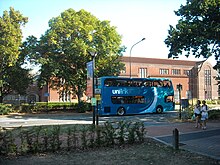
A Unilink double-decker bus passing through Highfield Campus
To connect the university's Southampton campuses, halls of residence, hospitals, and other important features of the city, the university operates the Unilink bus service for the benefit of the students, staff and the general public. The service is currently operated by local bus company Bluestar using the Unilink name. The service consists of four routes. The U1 runs between Southampton Airport and the National Oceanography Centre via Wessex Lane Halls, Highfield campus, Portswood, Southampton City Centre and Southampton Central railway station. The other regular routes, the U2 and the U6, run between the City Centre and Bassett Green and Southampton General Hospital respectively while the final route, the U9, runs an infrequent service between Southampton General hospital and Townhill Park. Students who live in some halls of residence receive an annual smart-card bus pass, allowing them to use all of the Unilink services without extra payment.[72]
The fleet of buses was replaced in September 2013 with new Alexander Dennis Enviro400 double-decker buses on most routes.[73][74]
Organisation
Governance

The George Thomas Student Services Building on Highfield Campus where the university management is located.
Responsibility for running the university is held formally by the Chancellor and led at the executive level by the Vice-Chancellor, currently Sir Christopher Snowden. The key bodies in the university governance structure are the Council, Court and Senate.
The Council is the governing body of the university.[75] It is ultimately responsible for the overall planning and management of the university.[75] The council is also responsible for ensuring that the funding made available to the university by the Higher Education Funding Council for England is used as prescribed.[75] The council is composed of members from 5 different classes, namely (1) officers; (2) twelve members appointed by the council; (3) six members appointed by the Senate; (4) one member of the non-teaching staff; (5) the President of the Students' Union.[75]
The University Court provides a forum for consultation with the local and regional community, to help promote public awareness of the university and to attract and maintain goodwill.[76] The court is composed of some 190 members, representatives of the university, which includes members of Council, Deans of the Faculties, Heads of Academic Schools, members of staff, students and graduates; representatives of local authorities and of schools and colleges in the region; members of the UK and European parliaments; and representatives of other local societies and bodies.[76]
The Senate is the university's primary academic authority, with responsibilities which include the direction and regulation of education and examinations, the award of degrees, and the promotion of research.[77] The Senate has approximately 150 members, including the Deputy Vice-Chancellors/Pro Vice-Chancellors, the Deans and Associate Deans of the Faculties, the Heads of the academic Schools and Research Centres, representatives from the academic staff in each School, representatives of the research staff and those administrative groups most closely associated with educational activities, and representatives of the Students' Union. The Senate is chaired by the Vice-Chancellor.[77]
Faculties
The university comprises five faculties, each with a number of academic units.[78] This current faculty structure came into effect in 2018, taking over from a previous structure consisting of eight faculties. The current faculty structure is:
Faculty of Arts and Humanities- Humanities
- Winchester School of Art
Faculty of Engineering and Physical Sciences- Chemistry
- Electronics and Computer Science
- Engineering
- Physics and Astronomy
Faculty of Environmental and Life Sciences- Biological Sciences
- Geography and Environmental Science
- Health Sciences (nursing, midwifery, allied health professionals)
- Ocean and Earth Sciences
- National Oceanography Centre
- Psychology
Faculty of Medicine- Southampton Medical School
Faculty of Social Sciences- Economic, Social and Political Sciences
- Southampton Statistical Sciences Research Institute
- Mathematical Sciences
- Southampton Business School
- Southampton Education School
- Southampton Law School
Affiliations
Southampton is a founding member of the Russell Group of research-intensive universities in Britain.[79]
Academic profile
Courses and subjects
Southampton awards a wide range of academic degrees spanning academic degrees for bachelor's in a variety of degrees and master's degrees as well as junior doctorates and higher doctorates. The postnominals awarded are the degree abbreviations used commonly among British universities.[citation needed] The university is part of the Engineering Doctorate scheme,[80] for the award of Eng. D. degrees.
Professional qualifications are also awarded, such as Qualified Teacher Status (QTS).[citation needed] Short courses and professional development courses are run by many of the university's Academic Schools and Research Centres.[81]
The university works closely with members of the Armed Forces.[81] It provides professional military educators in the British Army to study for a Postgraduate Certificate in Education (PGCE). The University also works with the Royal Navy to provide training and qualifications towards Chartered Engineer status.[81]
Admissions
| 2017 | 2016 | 2015 | 2014 | 2013 | |
|---|---|---|---|---|---|
Applications[82] | 39,735 | 42,405 | 36,850 | 36,600 | 36,705 |
Offer Rate (%)[83] | 78.5 | 82.2 | 84.0 | 80.5 | 77.7 |
Enrols[84] | 4,830 | 5,360 | 6,200 | 5,065 | 5,480 |
Yield (%) | 15.5 | 15.4 | 20.0 | 17.2 | 19.2 |
Applicant/Enrolled Ratio | 8.23 | 7.91 | 5.94 | 7.23 | 6.70 |
Average Entry Tariff[85][a] | n/a | 160 | 390 | 417 | 408 |
In terms of average UCAS points of entrants, Southampton ranked 28th in Britain in 2014.[86] The university gives offers of admission to 84.0% of its applicants, the 6th highest amongst the Russell Group.[87]
According to the 2017 Times and Sunday Times Good University Guide, approximately 15% of Southampton's undergraduates come from independent schools.[88] In the 2016–17 academic year, the university had a domicile breakdown of 72:7:21 of UK:EU:non-EU students respectively with a female to male ratio of 53:47.[89]
Rankings and reputation
| National rankings | |
|---|---|
Complete (2019)[90] | 20 |
Guardian (2019)[91] | 23 |
Times / Sunday Times (2019)[92] | 18 |
| Global rankings | |
ARWU (2018)[93] | 101–150 |
CWTS Leiden (2018)[94] | 125 |
QS (2019)[95] | 96 |
THE (2019)[96] | 118 |
| British Government assessment | |
Teaching Excellence Framework[97] | Bronze |
The University of Southampton was rated as one of the world's top 100 universities by the Times Higher Education Table in 2013,[98] while the 2015/2016 QS World University Rankings[99] ranked Southampton 81st overall in the world. Southampton is ranked 65th in the world (and 9th in the UK) in the 2018 Round University Ranking.,[100] while in the 2017 U.S. News & World Report ranks Southampton 97th in the world and 10th in the UK.[101]
As of 2014 the Webometrics Ranking of World Universities places Southampton 32nd worldwide and 5th in the UK,[102] the Center for World University Rankings ranks Southampton 11th in the UK,[103] and Scimago institutions rankings puts Southampton 11th for research output and 13th for scientific talent pool.[citation needed]
Southampton was awarded Bronze ("provision is of satisfactory quality") in the 2017 Teaching Excellence Framework, a government assessment of the quality of undergraduate teaching in universities and other higher education providers in England.[104] The Bronze award was appealed by the university,[105] however it was rejected by the HEFCE in August 2017.[106] In response, the university's Vice Chancellor, Christopher Snowden, claimed the exercise was "devoid of any meaningful assessment of teaching" and that "there are serious lessons to be learned if the TEF is to gain public confidence."[107] Enrolment into the exercise was voluntary and institutions were made aware of the metrics used before agreeing to be assessed by the TEF.[108] In January 2018, the university confirmed that it would re-enter the TEF believing that it would benefit from changed evaluations that would benefit Russell Group universities.[109]
Subject rankings
The University of Southampton is cited as being the UK's leading university for engineering.[110]The Guardian ranked the university at number 1 in the UK for Mechanical Engineering, Aeronautical Engineering, Naval Architecture, Electronic and Electrical Engineering in June 2010.[111][112]
Research
In the 2014 Research Excellence Framework assessing the research output of 154 British Universities and Institutes, Southampton was ranked 18th for GPA (15th among Russell Group Universities), 11th for research power (11th among Russell Group Universities), and 8th for research intensity (7th among Russell Group Universities).[113]
The university conducts research in most academic disciplines and is home to a number of notable research centres. Southampton has leading research centres in a number of disciplines, e.g. music, computer sciences, engineering or management sciences, and houses world-leading research institutions in fields as varied as oceanography and web science.[citation needed]
Research Institutes
Within the university there are a number of research institutes and groups that aim to pool resources on a specific research area.[81] Institutes or groups identified by the university of being of significant importance are marked in italics.
| University of Southampton Research Institutes and Groups | ||||||||||||||||||||||||||||||||||||||||||||||||||||||||||||||||||||||||||||||||||||||||||||||||||||||||||||||||||||||||||||||||||||||||||||||||||||||||||||||||||||||||||||||||||||||||||||||||||||||||||||||||||||||||||||||||||||||||||||||||||||||||||||||||||||||||||||||||||||||||||||||||||||||||||||||||||||||||||||||||||||||||||||||||||||||||||||||||||||||||||||||||||||||||||||||||||||||||||||||||||||||||||||||||||||||||||||||||||||||||||||||||||||||||||||||||||||||||||||||||||||||||||||||||||||||||||||||||||||||||||||||||||||||||||||||||||||||||||||||||||||||||||||||||||||||||||||||||||||||||||||||||||||||||||||||||||||||||||||||||||||||||||||||||||||||||||||||||||||||||||||||||||||||||||||||||||||||||||||||||||||||||||||||||||||||||||||||||||||||||||||||||||||||||||||
|---|---|---|---|---|---|---|---|---|---|---|---|---|---|---|---|---|---|---|---|---|---|---|---|---|---|---|---|---|---|---|---|---|---|---|---|---|---|---|---|---|---|---|---|---|---|---|---|---|---|---|---|---|---|---|---|---|---|---|---|---|---|---|---|---|---|---|---|---|---|---|---|---|---|---|---|---|---|---|---|---|---|---|---|---|---|---|---|---|---|---|---|---|---|---|---|---|---|---|---|---|---|---|---|---|---|---|---|---|---|---|---|---|---|---|---|---|---|---|---|---|---|---|---|---|---|---|---|---|---|---|---|---|---|---|---|---|---|---|---|---|---|---|---|---|---|---|---|---|---|---|---|---|---|---|---|---|---|---|---|---|---|---|---|---|---|---|---|---|---|---|---|---|---|---|---|---|---|---|---|---|---|---|---|---|---|---|---|---|---|---|---|---|---|---|---|---|---|---|---|---|---|---|---|---|---|---|---|---|---|---|---|---|---|---|---|---|---|---|---|---|---|---|---|---|---|---|---|---|---|---|---|---|---|---|---|---|---|---|---|---|---|---|---|---|---|---|---|---|---|---|---|---|---|---|---|---|---|---|---|---|---|---|---|---|---|---|---|---|---|---|---|---|---|---|---|---|---|---|---|---|---|---|---|---|---|---|---|---|---|---|---|---|---|---|---|---|---|---|---|---|---|---|---|---|---|---|---|---|---|---|---|---|---|---|---|---|---|---|---|---|---|---|---|---|---|---|---|---|---|---|---|---|---|---|---|---|---|---|---|---|---|---|---|---|---|---|---|---|---|---|---|---|---|---|---|---|---|---|---|---|---|---|---|---|---|---|---|---|---|---|---|---|---|---|---|---|---|---|---|---|---|---|---|---|---|---|---|---|---|---|---|---|---|---|---|---|---|---|---|---|---|---|---|---|---|---|---|---|---|---|---|---|---|---|---|---|---|---|---|---|---|---|---|---|---|---|---|---|---|---|---|---|---|---|---|---|---|---|---|---|---|---|---|---|---|---|---|---|---|---|---|---|---|---|---|---|---|---|---|---|---|---|---|---|---|---|---|---|---|---|---|---|---|---|---|---|---|---|---|---|---|---|---|---|---|---|---|---|---|---|---|---|---|---|---|---|---|---|---|---|---|---|---|---|---|---|---|---|---|---|---|---|---|---|---|---|---|---|---|---|---|---|---|---|---|---|---|---|---|---|---|---|---|---|---|---|---|---|---|---|---|---|---|---|---|---|---|---|---|---|---|---|---|---|---|---|---|---|---|---|---|---|---|---|---|---|---|---|---|---|---|---|---|---|---|---|---|---|---|---|---|---|---|---|---|---|---|---|---|---|---|---|---|---|---|---|---|---|---|---|---|---|---|---|---|---|---|---|---|---|---|---|---|---|---|---|---|---|---|---|---|---|---|---|---|---|---|---|---|---|---|---|---|---|---|---|---|---|---|---|---|---|---|---|---|---|---|---|---|---|---|---|---|---|---|---|---|---|---|---|---|---|---|---|---|---|---|---|---|---|---|---|---|---|---|---|---|---|---|---|---|---|---|---|---|---|---|---|---|---|---|---|---|---|---|---|---|---|---|---|---|---|---|---|---|---|---|---|---|---|---|---|---|---|---|---|---|---|---|---|---|---|---|---|---|---|---|---|---|---|---|---|---|---|---|---|---|---|---|---|---|---|---|---|---|---|---|---|---|---|---|---|---|---|---|---|---|---|---|---|---|---|---|---|---|---|---|---|---|---|---|---|---|---|---|---|---|---|---|---|
|
Institute of Sound and Vibration Research
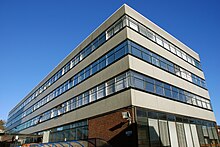
Institute of Sound and Vibration Research building
The Institute of Sound and Vibration Research (ISVR), is an acoustical research institute which is part of the University of Southampton. Founded in 1963, it has been awarded a 2006 Queen's Anniversary Prize for Higher and Further Education.[347]
ISVR is divided into four distinct groups of research:
- The Dynamics Group, (specialised in the modelling, measurement and control of structural vibrations).[348]
- The Fluid Dynamics and Acoustics Group (including the Rolls-Royce University Technology Centre in Gas Turbine Noise) specialised in three fields which are aero-acoustics of aircraft engines, ultrasonics and underwater acoustics, noise source imaging and virtual acoustics.[349]
- The Human Sciences Group (including the Hearing and Balance Centre and the Human Factors Research Unit) specialises in the human response to sound and vibration.[350]
- The Signal Processing and Control Group, which specialises in acoustics, dynamics, audiology and human sciences and as a basis for control of sound and vibration.[351]
ISVR offers a number of Undergraduate and Postgraduate degree programmes in acoustical engineering, acoustics & music and audiology.[352]
EPrints
The School of Electronics and Computer Science created the first archiving software (EPrints) to publish its research freely available on the Web.[353] This software is used throughout the university and as an archiving system for many different institutions around the world.[354]
Student life
Students' Union
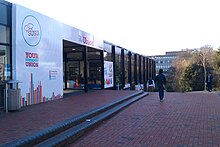
The Students' Union Building on Highfield Campus.
The University of Southampton Students' Union (SUSU.), is sited in three buildings opposite the Hartley Library. One, the West Building, dates back to the 1940s in a red brick style, complementing the Hartley Library opposite; the main building was built in the 1960s in the Basil Spence masterplan. This was extended with new nightclub and cinema facilities in 2002. The newest building was built during the mid-1990s which includes the recently refurbished union shop, on the ground floor with a hairdressers, Unilink office, and another retail outlet for clothing on the first floor.[citation needed]
The student union is actually separate from the University of Southampton, and is its own business. It gets funds partially from the university to finance many of its activities. The multiple award-winning student radio station, Surge, broadcasts from new studios in the main union building.[citation needed] The award-winning website[355] unionsouthampton.org was created and run by students at the university. A brand new purpose built studio has been constructed for the TV station SUSUtv. The student newspaper is now published once every three weeks as Wessex Scene. The Edge, originally an insert of the Wessex Scene, is now an editorially independent entertainment magazine.[citation needed]
Events are held in The Cube, the union's nightclub. The Cube also doubles up as the on campus cinema run by Union Films. The Bridge, the union's cocktail bar, and in the Stag's Head, the union pub. National touring bands play in the Garden Court in the West Building.[citation needed]
Halls of Residence
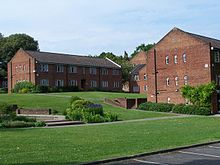
Old Block of Glen Eyre Halls of Residence.
The university provides accommodation for all first year students who require it and places in residences are further available for international and MSc students. Accommodation may be catered, self catered, have ensuite facilities, a sink in the room, or access to communal bathroom facilities. Each hall has a Junior Common Room (JCR) committee that is responsible for the running of social events and representing the residents to the students union and the university via the Students union JCR officer. Glen Eyre and Montefiore also have bars which are separately run by the students union and are staffed by current and ex residents.[citation needed]
The university's accommodation exists around two large complexes of halls and some other small halls located around the city, two of which are usually grouped into another collective entity.[citation needed] These are:
Glen Eyre Complex – The complex lies less than half a mile to the north of Highfield Campus and houses approximately 2000 students. The complex consists of several building sets, designed over the years and arranged either around the central landscaped garden – the oldest buildings, Richard Newitt Courts are separated into blocks A-G and are closest to the Glen Bar, students in these blocks have very small flats (between 4 and 6 to a kitchen with usually more than one bathroom). Old Terrace and New Terrace are close to the site's entrance, New Terrace has ensuite rooms. Chancellors' courts, consisting of Selbourne, Jellicoe and Roll courts are the most modern blocks in the accommodation with Brunei house, the most basic of accommodations, on the outskirts. The Chancellors' Courts are currently undergoing a scheme of minor refurbishment, with the final building, Roll Court due to be completed over Summer 2018. J Block was refurbished during 2016 and opened to residents in Autumn 2017. Located on the south side of Glen Eyre Road on the periphery of the site are Chamberlain Halls, which share most things with the main Glen Eyre site. This site consists of Hartley Grove, South Hill, Beechmount House and the new Chamberlain blocks which housed their first residents in 2016/17. All Glen Eyre Halls are self-catered at present.
Wessex Lane Halls – Located in Swaythling approximately one mile east of the Highfield Campus. The complex provides accommodation for over 1,800 students and currently comprises two halls of residence: Montefiore Hall, abbreviated as Monte (sub-divided into the four stages of construction), and Connaught, one of the original halls of residence of the university and sub-divided into the Old and New quads. Connaught Halls are fully catered. The complex also features South Stoneham House, a period building constructed in 1708, currently undergoing renovation and changes as a planned conference facility. The adjoining 17-storey South Stoneham tower block constructed in 1964 is awaiting demolition.
City Gateway Hall – Located in Swaythling one mile north east of the Highfield Campus at the intersection of two major roads. Opened in September 2015, the landmark building was included in the runners-up list of the 2015 Carbuncle Cup. Featuring a 15-story elliptical tower and two adjoining six-story rectangular accommodation blocks the hall provides accommodation for up to 375 students.[356][357][358]
Mayflower Halls – Located in the city centre within the city's 'Cultural Quarter', and two-minutes walk away from Southampton Central railway station. The hall opened at the start of the 2014/2015 academic year, and houses over 1100 students in a mix of ensuite, premium ensuite rooms, as well as some self-contained studio and one bedroom flats.
Archers Road – Lying two miles south of Highfield and housing 500 students, Archers Road compromises two halls on separate sites, grouped together for their close proximity alone. The two halls, Gateley and Romero, are all self-contained and self catered but share a reception and other community facilities. The university sold St. Margaret's Hall, previously part of the Archers Road complex to Fresh Student Living in 2016.
Bencraft Hall – Located a mile and a half north of Highfield and housing approximately 200 students, Bencraft is one of the smaller and cheaper halls of the university. Bencraft Hall has been closed for refurbishment since 2017.
Highfield Halls – Located adjacent to Avenue Campus and half a mile from Highfield campus. Highfield halls comprises Aubrey and Wolfe houses and both have on site catering. The site is also used as a University conference facility during the summer months when vacated.
Shaftesbury Avenue and Gower Building – These two sites are used by mature and postgraduate students. Shaftesbury Avenue is located near Portswood and is a mile from Highfield while the Gower building is located on Highfield campus. These two are a small number of self-contained apartments, in the case of the Gower building, located above other university amenities.
Liberty Point – Located in Central Southampton, this accommodation is not owned by the university but does provide approximately 300 accommodation spaces in partnership with the university.
Erasmus Park – Located in Winchester, this hall houses around 400 students studying at the Winchester School of Art.
The university also has accommodation located in Balmoral House and Victoria Place, Portsmouth and in Basingstoke for the use of Nursing and Midwifery students studying on placement in these areas.[citation needed]
Libraries
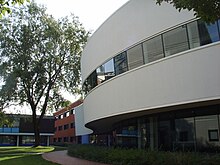
Exterior of the 2005 extension to the Hartley Library
The university has libraries located on each of the academic campuses and in total the collection holds over 1.5 million books and periodicals.[359]
The university's primary library is the Hartley Library, located on Highfield campus and first built in 1935 and extended further in 1959 and 2005.[359] The majority of the books and periodicals are held there as well as specialist collections of works such as Ford collection of Parliamentary papers and the European Documentation Centre. In addition, the main library houses the Special Collections and Archives centre, housing more than 6 million manuscripts and a large archive of rare books.[360] Specific collections include the correspondence of Arthur Wellesley, 1st Duke of Wellington, acquired by the university in 1983, as well as the Broadlands Archive, including the Palmerston and Mountbatten papers. The library also contains 4,500 volumes of Claude Montefiore's library on Theology and Judaism, the Ford Parliamentary Papers, Frank Perkins' collection of books on agriculture, Sir Samual Gurney-Dixons's Dante collection and the James Parkes Library of Jewish/non-Jewish relations.[360] The library also includes six rare editions of the Divina Commedia; the first of these, the Brescia edition of 1487, is the library's earliest book.[360]
In addition to the main Hartley Library, there are other libraries based at the university's other campuses primarily focused on the subjects studied at that location. As one of the smaller libraries and given its proximity to the Highfield campus, the Avenue Library only houses a collection of key Humanities resources.[361] It does however also hold an extensive film library, many of an international nature.[362] On a larger scale, the libraries at the National Oceanography Centre, Southampton General Hospital, Winchester School of Art are more complete and house the majority of the resources and specialist collections on oceanography and earth sciences, healthcare and art and design respectively.[363][364][365] The Malaysia campus holds a small collection of reference books but the majority of the resources needed for courses at the campus are available online.[366] Separate from the Hartley Library is the E. J. Richards Engineering Library, which contains further materials for more in-depth study and is freely accessible to Engineering students and staff.[367]
Arts
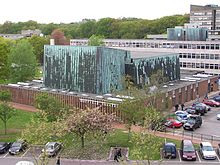
The Nuffield Theatre, Southampton
The university's main Highfield campus is home to three main arts venues supported and funded by the university and Arts Council England.[citation needed] The Nuffield Theatre opened in 1963 with construction funded by a grant from the Nuffield Foundation of £130,000 (£2,450,000 in 2013).[368] The building was designed by Sir Basil Spence as part of his campus masterplan with additional direction provided by Sir Richard Southern.[369] The theatre consists of a 480-seat auditorium, that also served as the principal lecture theatre at the time of construction, as well as additional lecture theatres and adjacent Kitchen bar.[370][371]
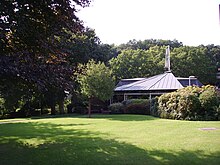
The Turner Sims Concert Hall on Highfield Campus.
The Turner Sims Concert Hall was added to the art provision in October 1974 following a £30,000 (£460,000 in 2012) donation from Margaret Grassam Sims in 1967.[372] It was made to provide a venue specifically for music following difficulties in gaining space in the Nuffield Theatre and due to acoustical differences with the spaces.[372] The new space has a single auditorium, designed by the university's Institute of Sound and Vibration Research with musical performances in mind, with a flat space at the bottom so it could be used for exams.[372]
The final of the three Art Council supported venues on campus is the John Hansard Gallery. The gallery was opened on 22 September 1980 but is housed in a building that previously housed a tidal model of Southampton Water between 1957 and 1978.[373] It took over responsibility from a photographic gallery, a gallery in the Nuffield Theatre and one located on Boldrewood campus.[373] It houses various exhibitions in contemporary art and is due to move to new premises in Guildhall Square in c.2015.[374]
These three centres are supplemented by the Special Collections Gallery, located on Level 4 of the Hartley Library and showing exhibitions from the university's archives and special collections, as well as gallery spaces located at the Winchester School of Art campus.[citation needed] In addition, the western half of Highfield campus contain several 20th-century sculptures by Barbara Hepworth,[375][376] Justin Knowles, Nick Pope and John Edwards.
Healthcare
There are two NHS practices on the campus: The University Health Service and Highfield Health. The larger of the two practices is University Health Service, with over 15,000 patients working from Building 48 between the Physics & Maths Buildings, whilst Highfield Health is the smaller practice serving around 3,000 patients from its location on 31 University Road.[citation needed]
Sports
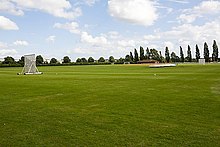
Wide Lane Sports Ground
The university's Sport and Wellbeing department runs the majority of the sports facilities on campus which are based predominately at two locations: the Jubilee Sports Centre and Wide Lane Sports Ground. The Jubilee Sports Centre, opened in 2004 at a cost of £8.5 million, is located on the Highfield Campus and contains a six-lane 25-metre swimming pool, 160 workstation gym and an eight-court sports hall.[377] Wide Lane meanwhile is located nearby in Eastleigh and was refurbished at cost of £4.3 million in 2007. The 73-acre (30 ha) complex includes flood-lit synthetic turf and grass pitches, tennis courts, a pavilion and a 'Team Southampton' Gym.[378] The university also runs facilities at the Avenue Campus, National Oceanography Centre, the Watersports Centre on the River Itchen and at Glen Eyre and Wessex Lane halls while there is another sports hall, squash courts, martial arts studio and bouldering wall located within the Students' Union.[377][378]
The university competes in numerous sports in the BUCS South East Conference (after switching from the Western Conference in 2009).[379] A number of elite athletes are supported by the SportsRec through sports bursaries and the UK Government's Talented Athlete Scholarship Scheme (TASS).
The University Athletic Union was formally established on 29 November 1929, by the University College council. Versions of the union had existed previously to which many clubs such as Cricket, Association Football, Rugby, Boxing, Gymnastics, Tennis and Boat clubs (all formed before the turn of the 20th century) were members.[380]
Mustangs Baseball Club
The Southampton Mustangs Baseball Club was founded in 1997. In the early years, the club participated in mainly friendly games against other British university baseball teams, as no formal university league was in existence. Starting in 1998, the Mustangs started to host a university baseball tournament – inviting other teams including Oxford, Cambridge, Portsmouth, Royal Holloway, and Norwich. In 2004 the Mustangs entered into the national adult baseball leagues run by the British Baseball Federation (BBF). The club entered in the lowest division, but after a few years of consolidation, the Mustangs have worked their way up from the lower leagues in the BBF to play in the top-tier league of the British baseball, the British National Baseball League (NBL), in the 2010 season.[381]
National student championships
Throughout its history the university has had a number of successful teams in national student championships.
| National Student Champions from the University of Southampton | ||||||||||||||||||||||||||||||||||||||||||||||||||||||||||||||||||||||||||||||||||||||||||||||||||||||||||||||||||||||||||||||||||||||||||||||||||||||||||||||||||||||||||||||||||||||||||||||||||||||||
|---|---|---|---|---|---|---|---|---|---|---|---|---|---|---|---|---|---|---|---|---|---|---|---|---|---|---|---|---|---|---|---|---|---|---|---|---|---|---|---|---|---|---|---|---|---|---|---|---|---|---|---|---|---|---|---|---|---|---|---|---|---|---|---|---|---|---|---|---|---|---|---|---|---|---|---|---|---|---|---|---|---|---|---|---|---|---|---|---|---|---|---|---|---|---|---|---|---|---|---|---|---|---|---|---|---|---|---|---|---|---|---|---|---|---|---|---|---|---|---|---|---|---|---|---|---|---|---|---|---|---|---|---|---|---|---|---|---|---|---|---|---|---|---|---|---|---|---|---|---|---|---|---|---|---|---|---|---|---|---|---|---|---|---|---|---|---|---|---|---|---|---|---|---|---|---|---|---|---|---|---|---|---|---|---|---|---|---|---|---|---|---|---|---|---|---|---|---|---|---|---|
|
Notable people
Academics
Academics working at the university include Sir Tim Berners-Lee, inventor of the World Wide Web,[383]Wendy Hall, inventor of Microcosm (hypermedia system) a predecessor of the World Wide Web, founding director of the Web Science Trust between the University of Southampton and MIT,[384]José Antonio Bowen, President of Goucher College and a Fellow of the Royal Society of Arts, Erich Zepler, who made leading contributions to radio receiver development,[385]David Payne, who invented EDFA for use in fibre optics cables,[386] Sir Barry Cunliffe, a pioneer of modern British archaeology,[387]Ray Monk, the biographer of Ludwig Wittgenstein, Albie Sachs, former Judge of the Constitutional Court of South Africa,[388] and Tim Holt, former President of the Royal Statistical Society and Office for National Statistics.[389]
See also
References
^ New UCAS Tariff system from 2016
^ "University of Southampton Calendar 2013/14 – Preface". University of Southampton. Retrieved 25 February 2013..mw-parser-output cite.citationfont-style:inherit.mw-parser-output .citation qquotes:"""""""'""'".mw-parser-output .citation .cs1-lock-free abackground:url("//upload.wikimedia.org/wikipedia/commons/thumb/6/65/Lock-green.svg/9px-Lock-green.svg.png")no-repeat;background-position:right .1em center.mw-parser-output .citation .cs1-lock-limited a,.mw-parser-output .citation .cs1-lock-registration abackground:url("//upload.wikimedia.org/wikipedia/commons/thumb/d/d6/Lock-gray-alt-2.svg/9px-Lock-gray-alt-2.svg.png")no-repeat;background-position:right .1em center.mw-parser-output .citation .cs1-lock-subscription abackground:url("//upload.wikimedia.org/wikipedia/commons/thumb/a/aa/Lock-red-alt-2.svg/9px-Lock-red-alt-2.svg.png")no-repeat;background-position:right .1em center.mw-parser-output .cs1-subscription,.mw-parser-output .cs1-registrationcolor:#555.mw-parser-output .cs1-subscription span,.mw-parser-output .cs1-registration spanborder-bottom:1px dotted;cursor:help.mw-parser-output .cs1-ws-icon abackground:url("//upload.wikimedia.org/wikipedia/commons/thumb/4/4c/Wikisource-logo.svg/12px-Wikisource-logo.svg.png")no-repeat;background-position:right .1em center.mw-parser-output code.cs1-codecolor:inherit;background:inherit;border:inherit;padding:inherit.mw-parser-output .cs1-hidden-errordisplay:none;font-size:100%.mw-parser-output .cs1-visible-errorfont-size:100%.mw-parser-output .cs1-maintdisplay:none;color:#33aa33;margin-left:0.3em.mw-parser-output .cs1-subscription,.mw-parser-output .cs1-registration,.mw-parser-output .cs1-formatfont-size:95%.mw-parser-output .cs1-kern-left,.mw-parser-output .cs1-kern-wl-leftpadding-left:0.2em.mw-parser-output .cs1-kern-right,.mw-parser-output .cs1-kern-wl-rightpadding-right:0.2em
^ ab "Southampton Financial Statement 2017" (PDF). University of Southampton. p. 27.
^ "CBI president to be next Chancellor of the University of Southampton". Archived from the original on 5 November 2011.
^ abc "2016/17 Students by HE provider, level, mode and domicile" (CSV). Higher Education Statistics Agency. Retrieved 25 March 2018.
^ Independent Schools Yearbook 2012–2013. ISBN 9781408181188.
^ "Student lists". Senate House Library. Archived from the original on 14 September 2010. Retrieved 4 April 2013.
^ "Research Excellence Framework results 2014" (PDF).
^ abc "Our Campuses". University of Southampton. Retrieved 3 July 2014.
^ "Boldrewood Campus". Times. Retrieved 15 October 2014.
^ "Winchester School of Art – University of Southampton". www.southampton.ac.uk.
^ "Library Services and Sites". Library. University of Southampton. Retrieved 3 July 2014.
^ "Facilities". Sports and Wellbeing. University of Southampton. Retrieved 3 July 2014.
^ Mann, John Edgar & Ashton, Peter (1998). Highfield, A Village Remembered. Halsgrove.
ISBN 1-874448-91-4.
^ Patterson, A. Temple (1962). "Henry Robinson Hartley and the Establishment of the Hartley Institution". The University of Southampton : A Centenary History of the Evolution and Development of the University of Southampton, 1862–1962. Southampton: The Camelot Press Ltd. pp. 9=-24.
^ ab Patterson, A. Temple (1962). "Southampton in the Middle of the Nineteenth Century". The University of Southampton : A Centenary History of the Evolution and Development of the University of Southampton, 1862–1962. Southampton: The Camelot Press Ltd. pp. 1–9.
^ Nash, Sally; Martin Sherwood (2002). "Growing Pains". University of Southampton : An Illustrated History. London: James and James. pp. 13–17. ISBN 0-907383-94-7.
^ Patterson, A. Temple (1962). "Reorganization and Achievement: 1892–1902". The University of Southampton : A Centenary History of the Evolution and Development of the University of Southampton, 1862–1962. Southampton: The Camelot Press Ltd. pp. 89–107.
^ Patterson, A. Temple (1962). ""The Old Hartley"". The University of Southampton : A Centenary History of the Evolution and Development of the University of Southampton, 1862–1962. Southampton: The Camelot Press Ltd. pp. 107–138.
^ abc Nash, Sally; Martin Sherwood (2002). "War and the Years After, 1939–1952". University of Southampton : An Illustrated History. London: James and James. pp. 44–57. ISBN 0-907383-94-7.
^ "Becoming a University". University of Southampton. Retrieved 13 June 2012.
^ ab Nash, Sally; Martin Sherwood (2002). "The Pre-Robbins Years, 1952–1965". University of Southampton : An Illustrated History. London: James and James. pp. 57–68. ISBN 0-907383-94-7.
^ ab Nash, Sally; Martin Sherwood (2002). "Who Pays the Piper, 1979–1985". University of Southampton : An Illustrated History. London: James and James. pp. 92–104. ISBN 0-907383-94-7.
^ abcde Nash, Sally; Martin Sherwood (2002). "Into the Premier League". University of Southampton : An Illustrated History. London: James and James. pp. 116–130. ISBN 0-907383-94-7.
^ Laurance, Jeremy (8 June 1998). "University offers students jab to fight meningitis". The Independent. London. Retrieved 10 April 2009.
^ "Jubilee Sports Centre". Estates Development. University of Southampton. Archived from the original on 23 February 2014. Retrieved 22 June 2013.
^ "Jubilee Sports Complex". Rick Mather Architects. Retrieved 22 June 2013.
^ "EEE Building (B32)". Estate Development. University of Southampton. Archived from the original on 30 August 2013. Retrieved 22 June 2013.
^ "EEE Building". John McAslan and Partners. Retrieved 22 June 2013.
^ "John McAslan and Partners: EEE Building University of Southampton". Architecture Today. Archived from the original on 25 December 2014. Retrieved 22 June 2013.
^ "Mountbatten Building". Estate Development. University of Southampton. Archived from the original on 25 May 2014. Retrieved 22 June 2013.
^ "Case Study: Mountbatten Building, University of Southampton". WYG Group. Retrieved 22 June 2013.
^ "Fire destroys top research centre". BBC. 31 October 2005. Retrieved 10 April 2009.
^ "Jestico & Whiles: Nanotechnology building, University of Southampton". Architecture Today. Retrieved 22 June 2013.
^ "Life Sciences Building (B85)". Estates Development. University of Southampton. Archived from the original on 23 February 2014. Retrieved 22 June 2013.
^ "A Meeting Place of the Minds". NBBJ. Retrieved 22 June 2013.
^ "NBBJ: Life Sciences Building, the University of Southampton". Architecture Today. Archived from the original on 26 September 2013. Retrieved 22 June 2013.
^ "Hartley Library Extension". University of Southampton. Archived from the original on 23 February 2014. Retrieved 22 June 2013.
^ "George Thomas Student Services Building (B37)". Estates Development. University of Southampton. Archived from the original on 23 February 2014. Retrieved 22 June 2013.
^ "George Thomas Building". Sustainable Planning Centre SISCo. Retrieved 22 June 2013.
^ "Students' Union Building". Estate Development. University of Southampton. Archived from the original on 23 February 2014. Retrieved 22 June 2013.
^ "University of Southampton Students' Union". Perkins Ogden Architects. Retrieved 22 June 2013.
^ "Archaeology". Estate Development. University of Southampton. Retrieved 23 June 2013.
^ "University of Southampton: New Archaeology and E-Languages Building" (PDF). Perkins Odgen Architects. Retrieved 23 June 2013.
^ "Institute of Developmental Sciences". Estate Development. University of Southampton. Retrieved 23 June 2013.
^ "Maritime Centre of Excellence (MCE)". University of Southampton. Archived from the original on 15 March 2013. Retrieved 23 June 2013.
^ "Science and Engineering South Consortium (SES-5)". University College London. 9 May 2013. Retrieved 17 August 2013.
^ "Our campuses: University of Southampton". University of Southampton. Retrieved 15 April 2011.
^ Gavin Stamp, 'Giles Gilbert Scott' in Oxford Dictionary of National Biography, Oxford University Press, 2004.
^ ab Nash, Sally; Martin Sherwood (2002). "Building a Vision". University of Southampton : An Illustrated History. London: James and James. pp. 272–281. ISBN 0-907383-94-7.
^ Sally Nash and Martin Sherwood (2002). The University of Southampton: An Illustrated History. Southampton: University of Southampton. p. 276. ISBN 0907383947.
^ Sally Nash and Martin Sherwood (2002). The University of Southampton: An Illustrated History. Southampton: University of Southampton. p. 132. ISBN 0907383947.
^ "Archaeology overview". University of Southampton. Retrieved 25 January 2013.
^ ab "National Oceanography Centre, Southampton". National Oceanography Centre. Retrieved 23 June 2013.
^ Sally Nash and Martin Sherwood (2002). The University of Southampton: An Illustrated History. Southampton: University of Southampton. pp. 235–247. ISBN 0907383947.
^ "University of Southampton: Malaysia Campus". University of Southampton. Retrieved 17 January 2012.
^ "University of Southampton: Malaysia" (PDF). Retrieved 17 January 2012.
[permanent dead link]
^ "Malaysia Campus in detail". University of Southampton. Retrieved 26 January 2013.
^ "University of Southampton: Malaysia Campus Engineering Foundation Year". University of Southampton. Retrieved 19 September 2017.
^ "University of Southampton: Malaysia Campus Engineering Programmes". University of Southampton. Retrieved 19 September 2017.
^ "UK's top engineering varsity opens first Malaysia campus". University of Southampton. Retrieved 19 September 2017.
^ "University of Southampton Malaysia Campus produces first group of engineering graduates". University of Southampton. Retrieved 19 September 2017.
^ "Malaysia Campus' Fishlock successfully defends PhD thesis". University of Southampton. Retrieved 19 September 2017.
^ "Southampton celebrates further achievements of Malaysia Campus graduates". University of Southampton. Retrieved 19 September 2017.
^ "New Southampton research hub redefines business and university relationships". University of Southampton. Retrieved 16 April 2011.
^ "University unveils vision for the UK's first 'professional campus'". University of Southampton. 10 April 2006. Archived from the original on 5 November 2011. Retrieved 17 August 2013.
^ "Science Park Property". 30 August 2009. Archived from the original on 22 June 2013. Retrieved 17 August 2013.
^ Tyler, Richard (13 March 2007). "UK equals US spin-out success". The Telegraph. London. Retrieved 5 September 2009.
^ "Southampton Spin-out Companies". Studyabroad.sg. 18 October 2011. Retrieved 17 August 2013.
^ "Invest in Southampton". 25 April 2006. Archived from the original on 28 September 2011. Retrieved 17 August 2013.
^ "Fundraising target met for £25m Southampton cancer centre". BBC News. 1 February 2018. Retrieved 24 July 2018.
^ "Immunology cancer centre in Southampton hits £25 million funding mark". Daily Echo. 1 February 2018. Retrieved 24 July 2018.
^ "Hall Fees". Southampton University. Retrieved 8 August 2018.
^ "Unilink – new fleet launches". Unilink (Bluestar). 4 September 2013. Archived from the original on 12 January 2014. Retrieved 27 September 2013.
^ Osborn, Steven (6 September 2013). "Unilink relaunch marks franchise anniversary". Retrieved 27 September 2013.
^ abcd "The University Council". University of Southampton. Retrieved 18 April 2009.
^ ab "The Court". Retrieved 18 April 2009.
^ ab "The Senate". Retrieved 18 April 2009.
^ "Faculties – University of Southampton". University of Southampton. Retrieved 27 November 2018.
^ "Our Universities". Russell Group. Retrieved 30 June 2012.
^ "Engineering Doctorate Centre Details". Engineering and Physical Sciences Research Council. Archived from the original on 7 February 2006. Retrieved 18 July 2006.
^ abcd Corporate and Marketing Services (2005). "University of Southampton Profile" (PDF). University of Southampton. Retrieved 12 April 2009.
^ "End of Cycle 2017 Data Resources DR4_001_03 Applications by provider". UCAS. UCAS. 2017. Retrieved 25 January 2018.
^ "Sex, area background and ethnic group: S27 University of Southampton". UCAS. UCAS. 2017. Retrieved 25 January 2018.
^ "End of Cycle 2017 Data Resources DR4_001_02 Main scheme acceptances by provider". UCAS. UCAS. 2017. Retrieved 25 January 2018.
^ "Top UK University League Table and Rankings". Complete University Guide.
^ "University League Table 2017". Complete University Guide. Retrieved 15 June 2016.
^ "Which elite universities have the highest offer rates". The Telegraph. Retrieved 21 October 2016.
^ "The Times and Sunday Times Good University Guide 2017". The Good University Guide. London. Retrieved 16 August 2016.
(subscription required)
^ "Where do HE students study?". hesa.ac.uk. Higher Education Statistics Authority. Retrieved 9 February 2018.
^ "University League Table 2019". The Complete University Guide.
^ "University league tables 2019". The Guardian. 29 May 2018.
^ "The Times and Sunday Times University Good University Guide 2019". Times Newspapers.
^ "Academic Ranking of World Universities 2018". Shanghai Ranking Consultancy.
^ "CWTS Leiden Ranking 2018 - PP top 10%". CWTS Leiden Ranking 2018.
^ "QS World University Rankings 2019". Quacquarelli Symonds Ltd.
^ "World University Rankings 2019". Times Higher Education.
^ "Teaching Excellence Framework outcomes". Higher Education Funding Council for England.
^ "Top 200 world universities". Times Higher Education. Archived from the original on 16 January 2013. Retrieved 17 August 2013.
^ "QS World University Rankings 2015/2016". QS World University Rankings. Retrieved 15 September 2015.
^ "World University Rankings". RUR Rankings Agency. Retrieved 22 September 2016.
^ "U.S. News and World Report Best Global Universities Rankings 2017". U.S. News and World Report.
^ , [1]
^ "United Kingdom - CWUR World University Rankings 2018-2019". Center for World University Rankings. Retrieved 26 September 2018.
^ "TEF Outcomes". HEFCE. Retrieved 27 June 2017.
^ Tyler, Samuel (24 June 2017). "University of Southampton Given Lowest Rank in TEF: University Responds". Wessex Scene. Retrieved 27 June 2017.
^ "UEA upgraded to gold in teaching excellence framework on appeal". Times Higher Education. Retrieved 15 August 2017.
^ "Teaching Excellence Framework statement". University of Southampton.
^ "Student guide to the TEF". HEFCE.
^ "Southampton and Soas return for TEF regrade". Times Higher Education. Retrieved 31 January 2018.
^ "University of Southampton".
^ "Mechanical Engineering at the University of Southampton". The Guardian. London. 8 June 2010.
^ "Electrical Engineering at the University of Southampton". The Guardian. London. 8 June 2010.
^ "REF 2014: winners and losers in 'intensity' ranking". Times Higher Education. Retrieved 31 May 2015.
^ "Centre for Banking, Finance and Sustainable Development". University of Southampton. Retrieved 27 September 2013.
^ "Centre for Complex Autonomous Systems Engineering". Archived from the original on 3 December 2013. Retrieved 27 September 2013.
^ "Centre for Health Ethics and Law". University of Southampton. Retrieved 27 September 2013.
^ "2005–2006 Events and Seminars Archive". University of Southampton. Retrieved 27 September 2013.
^ "CORMSIS – Centre for Operational Research, Management Sciences and Information Systems". University of Southampton. Retrieved 27 September 2013.
^ "Institute of Criminal Justice". University of Southampton. Retrieved 27 September 2013.
^ "Institute for Life Sciences". University of Southampton. Retrieved 27 September 2013.
^ "Centre for Law Ethics and Globalisation". Southampton Law School. University of Southampton. Archived from the original on 27 November 2013. Retrieved 27 September 2013.
^ "Centre for Risk Research". Southampton Business School. University of Southampton. Retrieved 27 September 2013.
^ "Centre for Research in Accounting, Accountability and Governance". Southampton Business School. University of Southampton. Retrieved 27 September 2013.
^ "Centre for Strategic Innovation". University of Southampton. Archived from the original on 24 September 2012. Retrieved 27 September 2013.
^ "Entrepreneurship Research Group". Southampton Business School. University of Southampton. Retrieved 27 September 2013.
^ "Finance and Banking Research Group". Southampton Business School. University of Southampton. Retrieved 27 September 2013.
^ "Institute for Law and the Web". University of Southampton. Retrieved 27 September 2013.
^ "Institute for Maritime Law". Southampton Law School. University of Southampton. Archived from the original on 28 February 2013. Retrieved 27 September 2013.
^ "Marketing Research Group". Southampton Business School. University of Southampton. Retrieved 19 October 2013.
^ "Organisational Behaviour/ Human Resource Research Group". Southampton Business School. University of Southampton. Retrieved 19 October 2013.
^ "Strategy and Innovation Research Group". Southampton Business School. University of Southampton. Retrieved 19 October 2013.
^ "Winchester Centre for Global Futures in Art Design & Media". Winchester School of Art. University of Southampton. Retrieved 19 October 2013.
^ "Aerodynamics and Flight Mechanics Research Group". Engineering and the Environment. University of Southampton. Retrieved 20 October 2013.
^ "Airbus Noise Technology Centre". University of Southampton. Retrieved 20 October 2013.
^ "Research Group: Astronautics". Engineering and the Environment. University of Southampton. Retrieved 28 October 2013.
^ "Bioengineering Science Research Group". Engineering and the Environment. University of Southampton. Retrieved 28 October 2013.
^ "Carbon Management Research Group". Engineering and the Environment. University of Southampton. Retrieved 28 October 2013.
^ "Centre for Environmental Sciences". Engineering and the Environment. University of Southampton. Retrieved 28 October 2013.
^ "Computational Engineering and Design". Engineering and the Environment. University of Southampton. Retrieved 28 October 2013.
^ abc "Research Centres". Engineering and the Environment. University of Southampton. Retrieved 28 October 2013.
^ "Industrial Collaborators". Institute of Medical and Biological Engineering. University of Leeds. Archived from the original on 2 December 2013. Retrieved 28 October 2013.
^ "ISVR Dynamics Group". Engineering and the Environment. University of Southampton. Retrieved 28 October 2013.
^ "Electro-Mechanical Engineering Research Group". Engineering and the Environment. University of Southampton. Retrieved 28 October 2013.
^ "Energy and Climate Change Research Group". Engineering and the Environment. University of Southampton. Retrieved 28 October 2013.
^ "Energy Technology Research Group". Engineering and the Environment. University of Southampton. Retrieved 28 October 2013.
^ "Engineering Materials Research Group". Engineering and the Environment. University of Southampton. Retrieved 28 October 2013.
^ "ISVR Fuid Dynamics and Acoustics Group". Engineering and the Environment. University of Southampton. Archived from the original on 28 October 2013. Retrieved 28 October 2013.
^ "Fluid Structure Interactions Research Group". Engineering and the Environment. University of Southampton. Retrieved 28 October 2013.
^ "Who we are". Audiology. University of Southampton. Retrieved 28 October 2013.
^ "Human Factors Research Unit". Institute of Sound and Vibration Research. University of Southampton. Retrieved 28 October 2013.
^ "A list of publications". HFRU, ISVR. University of Southampton. Archived from the original on 3 December 2013. Retrieved 28 October 2013.
^ "Infrastructure Group". Engineering and the Environment. University of Southampton. Retrieved 28 October 2013.
^ ab "Institute of Sound and Vibration Research". Engineering and the Environment. University of Southampton. Retrieved 28 October 2013.
^ ab "Microsoft Institute for High Performance Computing". Engineering and the Environment. University of Southampton. Retrieved 28 October 2013.
^ "National Centre for Advanced Tribology". University of Southampton. Retrieved 28 October 2013.
^ "National Centre for Advanced Tribology formally launched Nov '09". nCATS. University of Southampton. Archived from the original on 2 December 2013. Retrieved 28 October 2013.
^ "Rolls-Royce University Technology Centre at Southampton". Engineering and the Environment. University of Southampton. Retrieved 28 October 2013.
^ "Rolls-Royce University Technology Centre in Gas Turbine Noise". Engineering and the Environment. University of Southampton. Retrieved 28 October 2013.
^ ab "RNLI Advanced Technology Partnership". Engineering and the Environment. University of Southampton. Retrieved 28 October 2013.
^ "ISVR Signal Processing and Control Group". Engineering and the Environment. University of Southampton. Retrieved 28 October 2013.
^ ab "Transportation Research Group". Engineering and the Environment. University of Southampton. Retrieved 28 October 2013.
^ "Waste Management Research Group". Engineering and the Environment. University of Southampton. Retrieved 28 October 2013.
^ "Water and Environmental Engineering Group". Engineering and the Environment. University of Southampton. Retrieved 28 October 2013.
^ "Cancer, Palliative and End of Life Care Research Group". University of Southampton. Archived from the original on 3 December 2013. Retrieved 28 October 2013.
^ "Macmillan Survivorship Research Group". University of Southampton. Retrieved 28 October 2013.
^ "Research project: Macmillan Survivorship Research Group – 5 year research programme". Health Sciences. University of Southampton. Retrieved 28 October 2013.
^ "Organisation and Delivery of Care Research Group". Health Sciences. University of Southampton. Retrieved 28 October 2013.
^ "Rehabilitation and Health Technologies Research Group". Health Sciences. University of Southampton. Retrieved 28 October 2013.
^ "Research Group: 19th and early 20th Century European Philosophy". Philosophy. University of Southampton. Retrieved 28 October 2013.
^ "Analytic Aesthetics and the History of Aesthetics Research Group". Philosophy. University of Southampton. Retrieved 28 October 2013.
^ "Archaeological Computing Research Group". University of Southampton. Retrieved 28 October 2013.
^ "About the ACRG". University of Southampton. Retrieved 28 October 2013.
^ ab "Research Group: Archaeological Prospection Service of Southampton (APSS)". Archaeology. University of Southampton. Retrieved 3 November 2013.
^ ab "Centre for Applied Archaeological Analyses". Archaeology. University of Southampton. Retrieved 3 November 2013.
^ "Centre for Applied Human Origins Research". Archaeology. University of Southampton. Retrieved 3 November 2013.
^ "Centre for Applied Language research". University of Southampton. Retrieved 3 November 2013.
^ abc "Research". Modern Languages. University of Southampton. Retrieved 3 November 2013.
^ "Centre for the Archaeology of Human Origins". University of Southampton. Archived from the original on 5 November 2013. Retrieved 3 November 2013.
^ "Centre for Global Englishes". University of Southampton. Retrieved 3 November 2013.
^ ab "Centre for Imperial and Post Colonial Studies". History. University of Southampton. Retrieved 3 November 2013.
^ "Centre for Language, Linguistics and Area Studies". LLAS. Retrieved 3 November 2013.
^ "About LLAS". LLAS. Retrieved 3 November 2013.
^ "Centre for Maritime Archaeology". University of Southampton. Retrieved 3 November 2013.
^ "About the CMA". University of Southampton. Retrieved 3 November 2013.
^ "Centre for Medieval and Renaissance Culture". University of Southampton. Retrieved 3 November 2013.
^ "Mexsu". University of Southampton. Retrieved 3 November 2013.
^ "Centre for Modern and Contemporary Writing". English. University of Southampton. Retrieved 3 November 2013.
^ "Centre for Transnational Studies". University of Southampton. Retrieved 3 November 2013.
^ "Classical and Historical Archaeology Research Group". Archaeology. University of Southampton. Retrieved 3 November 2013.
^ "Composition and Music Technology Research Group". Music. University of Southampton. Retrieved 3 November 2013.
^ "Early Modern and Modern Philosophy Research Group". Philosophy. University of Southampton. Retrieved 28 October 2013.
^ "Ethics and Practical Reason Research Group". Philosophy. University of Southampton. Retrieved 28 October 2013.
^ "Languages South East". Languages South East. Archived from the original on 20 October 2011. Retrieved 3 November 2013.
^ "About us". Languages South East. Archived from the original on 20 October 2011. Retrieved 3 November 2013.
^ "Maritime Archaeology Research Group". Archaeology. University of Southampton. Archived from the original on 3 December 2013. Retrieved 3 November 2013.
^ "Music Performance Research Group". University of Southampton. Retrieved 3 November 2013.
^ "Musicology and Ethnomusicology Research Group". Music. University of Southampton. Retrieved 3 November 2013.
^ "Osteo-archaeology research group". Archaeology. University of Southampton. Retrieved 3 November 2013.
^ "Parkes Institute". University of Southampton. Retrieved 3 November 2013.
^ "About us". Parkes Institute. Retrieved 3 November 2013.
^ "Philosophy of Language, Philosophy of Mind and Epistemology Research Group". Philosophy. University of Southampton. Retrieved 28 October 2013.
^ "Routes into Languages". Routes into Languages. Retrieved 3 November 2013.
^ "£3.1 million to boost student demand for modern foreign language courses". Routes into Languages. Archived from the original on 2 December 2013. Retrieved 3 November 2013.
^ "Social Prehistory research group". Archaeology. University of Southampton. Retrieved 3 November 2013.
^ "Southampton Centre for Eighteenth Century Studies". University of Southampton. Retrieved 3 November 2013.
^ "Southampton Centre for Nineteenth-Century Research". University of Southampton. Retrieved 3 November 2013.
^ "Research". English. University of Southampton. Retrieved 3 November 2013.
^ "About us". SCNCR. University of Southampton. Retrieved 3 November 2013.
^ "Southampton Ceramics Research Group". Archaeology. University of Southampton. Retrieved 3 November 2013.
^ "sotonDH". University of Southampton. Retrieved 3 November 2013.
^ "Theory, representation and cultural politics research group". Archaeology. University of Southampton. Retrieved 3 November 2013.
^ "Wittgenstein and Early Analytic Philosophy Research Group". Philosophy. University of Southampton. Retrieved 28 October 2013.
^ "Developmental Origins of Health and Disease". Medicine. University of Southampton. Retrieved 3 November 2013.
^ "Centre for Human Development, Stem Cells and Regeneration". University of Southampton. Retrieved 3 November 2013.
^ abcd "Research Centres". Medicine. University of Southampton. Retrieved 3 November 2013.
^ ab "MRC Lifecourse Epidemiology Unit". University of Southampton. Retrieved 3 November 2013.
^ ab "NIHR Southampton Biomedical Research Centre in nutrition". University Hospital Southampton NHS Foundation Trust. Retrieved 3 November 2013.
^ ab "NIHR Southampton Respiratory Biomedical Research Unit". University Hospital Southampton NHS Foundation Trust. Retrieved 18 November 2013.
^ "Southampton Experimental Cancer Medicine Centre". University Hospital Southampton NHS Foundation Trust. Retrieved 18 November 2013.
^ "NIHR Wellcome Trust Clinical Research Facility". University Hospital Southampton NHS Foundation Trust. Retrieved 18 November 2013.
^ "Southampton Cancer Research UK Centre". University of Southampton. Retrieved 3 November 2013.
^ "Translational Immunology". Institute for Life Sciences. University of Southampton. Retrieved 3 November 2013.
^ ab "Clinical Trials Unit". University of Southampton. Retrieved 18 November 2013.
^ "Biomedical Sciences Research Group". Centre for Biological Sciences. University of Southampton. Retrieved 18 November 2013.
^ ab "Centre for Marine Microsystems". University of Southampton. Retrieved 19 November 2013.
^ "Characterisation and Analytics Research Group". Chemistry. University of Southampton. Retrieved 18 November 2013.
^ "Computational Systems Research Group". Chemistry. University of Southampton. Retrieved 18 November 2013.
^ "Education Research Group". Chemistry. University of Southampton. Retrieved 18 November 2013.
^ "Electrochemistry Research Group". Chemistry. University of Southampton. Retrieved 18 November 2013.
^ "Environmental Biosciences Research Group". Centre for Biological Sciences. University of Southampton. Retrieved 18 November 2013.
^ "Geochemistry Group". Ocean and Earth Science, NOCS. University of Southampton. Retrieved 18 November 2013.
^ "Geology and Geophysics Research Group". Ocean and Earth Sciences, NOCS. University of Southampton. Retrieved 18 November 2013.
^ "Magnetic Resonance Research Group". Chemistry. University of Southampton. Retrieved 18 November 2013.
^ "Marine Biogeochemistry Research Group". Ocean and Earth Science, NOCS. University of Southampton. Retrieved 18 November 2013.
^ "Marine Biology and Ecology Research Group". Ocean and Earth Sciences, NOCS. University of Southampton. Retrieved 18 November 2013.
^ "Molecular and Cellular Biosciences Research Group". Centre for Biological Sciences. University of Southampton. Retrieved 18 November 2013.
^ "Molecular Assembly, Function and Structure Research Group". Chemistry. University of Southampton. Archived from the original on 3 December 2013. Retrieved 18 November 2013.
^ "Molecular Diagnostics and Therapeutics Research Group". Chemistry. University of Southampton. Archived from the original on 3 December 2013. Retrieved 18 November 2013.
^ "Research Groups". Ocean and Earth Science, National Oceanography Centre Southampton. University of Southampton. Retrieved 19 November 2013.
^ "Palaeoceanography and Palaeclimate Research Group". Ocean and Earth Science, NOCS. University of Southampton. Retrieved 19 November 2013.
^ "Physical Oceanography Research Group". Ocean and Earth Science, NOCS. University of Southampton. Retrieved 19 November 2013.
^ "Research Group: Research Facilities". Centre for Biological Sciences, University of Southampton. Archived from the original on 3 December 2013. Retrieved 18 November 2013.
^ "Southampton Marine and Maritime Institute". University of Southampton. Retrieved 19 November 2013.
^ "Southampton Marine and Maritime Institute a 'catalyst for research and economic growth'". SMMI. University of Southampton. Retrieved 19 November 2013.
^ ab "Southampton Neuroscience Group". University of Southampton. Retrieved 18 November 2013.
^ "Academic Centre of Excellence in Cybersecurity". University of Southampton. Retrieved 24 November 2013.
^ "News and Events". Academic Centre of Excellence in Cybersecurity. University of Southampton. Retrieved 24 November 2013.
^ "Adaptive Photonics Group". University of Southampton. Archived from the original on 3 December 2013. Retrieved 24 November 2013.
^ abcdefghijklmnopqrstuvwxyzaaabacadaeaf "Research Groups". Optoelectronics Research Centre. University of Southampton. Retrieved 24 November 2013.
^ "Agents, Interaction and Complexity Research Group". University of Southampton. Retrieved 24 November 2013.
^ "Astronomy Research Group". University of Southampton. Retrieved 24 November 2013.
^ "Communications, Signal Processing and Control Research Group". University of Southampton. Retrieved 24 November 2013.
^ "Electronic and Software Systems Research Group". University of Southampton. Retrieved 24 November 2013.
^ "Electronics and Electrical Engineering Research Group". University of Southampton. Retrieved 24 November 2013.
^ "About Us". EEE Research Group. University of Southampton. Retrieved 24 November 2013.
^ "EPrints". EPrints (University of Southampton). Retrieved 24 November 2013.
^ "Welcome to the Energy Harvesting Network". Energy Harvesting Network. Retrieved 24 November 2013.
^ "Hybrid Photonics Research Group". University of Southampton. Retrieved 24 November 2013.
^ "Institute for Complex Systems Simulation". University of Southampton. Retrieved 24 November 2013.
^ "ICSS Launch Event". ICSS. University of Southampton. Retrieved 24 November 2013.
^ "The IT Innovation Centre". University of Southampton. Retrieved 24 November 2013.
^ "Laboratory for Inorganic Colloidal Nanocrystals". University of Southampton. Retrieved 24 November 2013.
^ "Magnetism and Superconductivity Research Group". University of Southampton. Archived from the original on 3 December 2013. Retrieved 24 November 2013.
^ "Research Centres". School of Electronics and Computer Science. University of Southampton. Retrieved 24 November 2013.
^ "Nanomaterials Research Group". University of Southampton. Retrieved 24 November 2013.
^ "Nano Research Group". University of Southampton. Retrieved 24 November 2013.
^ "Optoelectronics Research Centre". University of Southampton. Retrieved 24 November 2013.
^ "About the ORC". Optoelectronics Research Centre. University of Southampton. Retrieved 24 November 2013.
^ "ORCHID". ORCHID Project. Retrieved 24 November 2013.
^ "Pervasive Systems Centre". University of Southampton. Retrieved 24 November 2013.
^ "Quantum Control Group". University of Southampton. Retrieved 24 November 2013.
^ "Quantum Light and Matter Research Group". University of Southampton. Retrieved 24 November 2013.
^ "Quantum Nanophysics and Matter Wave Interferometry Research Group". University of Southampton. Retrieved 24 November 2013.
^ "Southampton High Energy Physics theory group". University of Southampton. Retrieved 24 November 2013.
^ "Southampton Nanofabrication Centre". University of Southampton. Retrieved 24 November 2013.
^ "Space Environment Physics Group". University of Southampton. Archived from the original on 3 December 2013. Retrieved 24 November 2013.
^ "Synote". University of Southampton. Retrieved 24 November 2013.
^ "The Terahertz Laboratories". University of Southampton. Retrieved 24 November 2013.
^ "Theory of Light Matter Coupling in Nanostructures Research Group". University of Southampton. Archived from the original on 5 July 2013. Retrieved 24 November 2013.
^ "VECSEL". University of Southampton. Retrieved 24 November 2013.
^ "Web and Internet Science Research Group". University of Southampton. Retrieved 24 November 2013.
^ "Web Science Doctoral Training Centre". University of Southampton. Retrieved 24 November 2013.
^ ab "About Us". Web Science Trust. Retrieved 24 November 2013.
^ "Web Science Institute". University of Southampton. Retrieved 24 November 2013.
^ "Southampton University launches Web Science Institute". BBC News. 11 November 2013. Retrieved 24 November 2013.
^ "Zepler Institute". University of Southampton. Retrieved 24 November 2013.
^ "UK's largest photonics and electronics centre to launch in Southampton". University of Southampton. Retrieved 24 November 2013.
^ "Applied Mathematics Research Group". Mathematics. University of Southampton. Retrieved 25 November 2013.
^ "Centre for Applications of Health Psychology (CAHP)". Psychology. University of Southampton. Archived from the original on 3 December 2013. Retrieved 25 November 2013.
^ "Centre for Applied Social Surveys". University of Southampton. Retrieved 25 November 2013.
^ "Centre for Charitable Giving and Philanthropy". Cass Business School. Retrieved 26 November 2013.
^ "Centre for Citizenship, Globalisation and Governance (C2G2)". Social Sciences. University of Southampton. Retrieved 25 November 2013.
^ ab "CHEMPaS". Southampton Education School. University of Southampton. Retrieved 25 November 2013.
^ "Centre for Global Health, Population, Poverty and Policy (GHP3)". University of Southampton. Retrieved 25 November 2013.
^ "Centre for Research on Ageing". University of Southampton. Retrieved 25 November 2013.
^ "Centre for Research on Self and Identity (CRSI)". Psychology. University of Southampton. Retrieved 25 November 2013.
^ "Centre for Sexual Health Research (CSHR)". Psychology. University of Southampton. Retrieved 25 November 2013.
^ "Centre for Vision and Cognition (CVC)". Psychology. University of Southampton. Retrieved 25 November 2013.
^ abc "Research Centres". Southampton Education School. University of Southampton. Retrieved 25 November 2013.
^ "Design and Utilisation of Digital Technologies Research Group". Southampton Education School. University of Southampton. Retrieved 25 November 2013.
^ ab "Developmental Brain-Behaviour Unit". Psychology. University of Southampton. Retrieved 25 November 2013.
^ "Earth Surface Dynamics Research Group". Geography and the Environment. University of Southampton. Retrieved 25 November 2013.
^ "Economy, Society and Space Research Group". Geography and the Environment. University of Southampton. Retrieved 25 November 2013.
^ "Educational and Career Decision-making Research Group". Southampton Education School. University of Southampton. Retrieved 25 November 2013.
^ "Educational Leadership, Management and Administration Research Group". Southampton Education School. University of Southampton. Retrieved 25 November 2013.
^ ab "Emotion and Personality Bio-behavioural Laboratory". Psychology. University of Southampton. Retrieved 25 November 2013.
^ ab "The Care Life cycle". University of Southampton. Retrieved 25 November 2013.
^ ab "Centre for Population Change". ESRC. Retrieved 25 November 2013.
^ "National Centre for Research Methods (NCRM)". NCRM. Retrieved 25 November 2013.
^ "Who we are". NCRM. Retrieved 25 November 2013.
^ "Third Sector Research Centre (TSRC)". TSRC / University of Birmingham. Retrieved 25 November 2013.
^ "The Centre". TSRC / University of Birmingham. Retrieved 25 November 2013.
^ "Experimental Psychopathology Laboratory (EPL)". Psychology. University of Southampton. Retrieved 25 November 2013.
^ "GeoData Institute". University of Southampton. Retrieved 25 November 2013.
^ "About the GeoData Institute". University of Southampton. Retrieved 25 November 2013.
^ "Global Environment Change and Earth Observation Research Group". Geography and the Environment. University of Southampton. Retrieved 25 November 2013.
^ "Higher Education Research Group". Southampton Education School. University of Southampton. Retrieved 25 November 2013.
^ "Inclusion and Special Education Research Group". Southampton Education School. University of Southampton. Retrieved 25 November 2013.
^ "The International Centre for Child Wellbeing". University of Southampton. Retrieved 26 November 2013.
^ "Internationalisation of HE Special Interest Group". Southampton Education School. University of Southampton. Retrieved 25 November 2013.
^ "Language and Literacy in Education Research Group". Southampton Education School. University of Southampton. Retrieved 25 November 2013.
^ "Leadership, School Improvement and Effectiveness (LSIE) Research Centre". Southampton Education School. University of Southampton. Retrieved 25 November 2013.
^ "Lifelong and Work-Related Learning (LaWRL) Research Centre". Southampton Education School. University of Southampton. Retrieved 25 November 2013.
^ "Marketing and Marketisation in Education Research Group". Southampton Education School. University of Southampton. Retrieved 25 November 2013.
^ ab "Mathematics Education Special Interest Group". Southampton Education School. University of Southampton. Retrieved 25 November 2013.
^ "Mathematics and Science Education (MaSE) Research Centre". Southampton Education School. University of Southampton. Retrieved 25 November 2013.
^ "Operational Research Group". Mathematics. University of Southampton. Retrieved 25 November 2013.
^ "Palaeoenvironmental Laboratory at the University of Southampton (PLUS)". Geography and the Environment. University of Southampton. Retrieved 25 November 2013.
^ "Population, Health and Wellbeing Research Group (PHeW)". Geography and the Environment. University of Southampton. Retrieved 25 November 2013.
^ "Pure Mathematics Research Group". Mathematics. University of Southampton. Retrieved 25 November 2013.
^ "Quantitative Methodologies Special Interest Group". Southampton Education School. University of Southampton. Retrieved 25 November 2013.
^ "Race and Ethnicity Special Interest Group". Southampton Education School. University of Southampton. Retrieved 25 November 2013.
^ "Research in Teacher Education (RITE) Special Interest Group". Southampton Education School. University of Southampton. Retrieved 25 November 2013.
^ "School Improvement and Effectiveness Research Group". Southampton Education School. University of Southampton. Retrieved 25 November 2013.
^ "Science Education Special Interest Group". Southampton Education School. University of Southampton. Retrieved 25 November 2013.
^ "Social Justice and Inclusive Education (SJIE) Research Centre". Southampton Education School. University of Southampton. Retrieved 25 November 2013.
^ "South Asian Communities (SAC) special interest group". Southampton Education School. University of Southampton. Retrieved 25 November 2013.
^ "SIMM- The Southampton Initiative in Mathematical Modelling". Mathematics. University of Southampton. Retrieved 25 November 2013.
^ "Southampton Practice Research Initiative Network Group (SPRING)". University of Southampton. Archived from the original on 2 December 2013. Retrieved 26 November 2013.
^ "Southampton Statistical Sciences Research Institute". University of Southampton. Retrieved 25 November 2013.
^ "Who are we". S3RI. University of Southampton. Retrieved 25 November 2013.
^ "Southampton Theory Astrophysics and Gravity Research Centre (STAG)". University of Southampton. Retrieved 25 November 2013.
^ "Statistics Research Group". Mathematics. University of Southampton. Retrieved 25 November 2013.
^ "Teaching and learning through the life-course Research Group". Southampton Education School. University of Southampton. Retrieved 25 November 2013.
^ "Work Futures Research Centre". University of Southampton. Retrieved 25 November 2013.
^ "Work-related and Workplace Learning Research Group". Southampton Education School. University of Southampton. Retrieved 25 November 2013.
^ "Institute of Sound and Vibration Research".
^ "ISVR Dynamics Group – Engineering and the Environment – University of Southampton". Retrieved 31 May 2015.
^ "Fluid Dynamics and Acoustics Group – Engineering and the Environment – University of Southampton". Retrieved 31 May 2015.
^ "ISVR Human Sciences Group".
^ "Signal Processing and Control Group – Engineering and the Environment – University of Southampton". Retrieved 31 May 2015.
^ "ISVR Teaching Programmes".
^ "Eprints.org Software for Creating Institutional and Individual Open Archives". Retrieved 11 October 2017.
^ "Registry of Open Access Repositories". Retrieved 11 October 2017.
^ "Webby Honorees 2008, Student Category". Archived from the original on 11 May 2008. Retrieved 5 June 2008.
^ "London's Walkie Talkie judged UK's worst building". BBC. BBC News Online. 2 September 2015. Retrieved 2 September 2015.
^ "Student Residential Accommodation". Estate Development. University of Southampton. Retrieved 24 June 2013.
^ "Student Residential Accommodation". BBC. Retrieved 12 December 2014.
^ ab "Hartley Library Extension". southampton.ac.uk. Archived from the original on 23 February 2014. Retrieved 16 April 2009.
^ abc Nash, Sally; Martin Sherwood (2002). "Professional Support Services". University of Southampton : An Illustrated History. London: James and James. pp. 256–268. ISBN 0-907383-94-7.
^ "Avenue Library". University of Southampton. Retrieved 3 December 2013.
^ "Film Collection – Avenue". University of Southampton. Retrieved 3 December 2013.
^ "National Oceanographic Library". University of Southampton. Retrieved 3 December 2013.
^ "Health Services Library". University of Southampton. Retrieved 3 December 2013.
^ "Winchester School of Art Library". University of Southampton. Retrieved 3 December 2013.
^ "Malaysia Campus". University of Southampton. Retrieved 3 December 2013.
^ "E. J. Richards Library". University of Southampton. Retrieved 3 December 2013.
^ Temple Patterson, A. (1962). The University of Southampton: A Centenary History of the Evolution and Development of the University of Southampton, 1862 – 1962. Southampton: University of Southampton. pp. 222–223.
^ "History". Nuffield Theatre. Retrieved 28 November 2013.
^ "Venue Hire". Nuffield Theatre. Retrieved 28 November 2013.
^ "Nuffield Theatre Building 6". University of Southampton. Retrieved 28 November 2013.
^ abc Sally Nash, Martin Sherwood (2002). The University of Southampton: An Illustrated History. University of Southampton. p. 85. ISBN 9780907383949.
^ ab Sally Nash, Martin Sherwood (2002). The University of Southampton: An Illustrated History. University of Southampton. pp. 72–73. ISBN 9780907383949.
^ "About Us". John Hansard Gallery. Retrieved 28 November 2013.
^ Penelope Curtis, Barbara Hepworth. Tate Publishing,
ISBN 1-85437-225-4
^ Barbara Hepworth, Hepworth, Barbara: A Pictorial Autobiography. Tate Publishing,
ISBN 1-85437-149-5.
^ ab "Indoor Facilities". University of Southampton Sport and Wellbeing. Retrieved 27 September 2013.
^ ab "Outdoor Facilities". University of Southampton Sport and Wellbeing. Retrieved 27 September 2013.
^ Potter, Henry (20 March 2009). "Southampton Move East". The Wessex Scene. Retrieved 12 September 2009.
^ Slater, Paul (2002). "The Early Days". The Athletic Union and some of its people 1862–2001. Southampton University Students' Union.
^ Britain's top baseball league to expand in 2010
The Southampton University Team expanded into a Baseball and Softball Society in 2014 turning it into a mixed society. The team placed 3rd at their first appearance at the M1ST competition in Loughborough in 2016. [2] British Baseball Federation
^ abcdefghijklmnopqrstuvwxyzaaabacadaeafagahaiajakalamanaoapaqarasatauavawax Slater, Paul (2002). "Appendix 2". The Athletic Union and some of its people 1862–2001. Southampton University Students' Union.
^ "World Wide Web Consortium People: Tim Berners-Lee". w3.org. Retrieved 19 January 2009.
^ "The Microcosm Link Service and its Application to the World Wide Web". Retrieved 23 July 2018.
^ "ECS Profile: Eric Zepler". zepler.net. Retrieved 19 January 2009.
^ "Meet the innovators: David Payne". BBC. 8 April 2008. Retrieved 19 January 2009.
^ "Professor Barry Cunliffe CBE and Jane Kennedy are appointed English Commissioners" (PDF). March 2006. Archived from the original (PDF) on 9 June 2011. Retrieved 19 January 2009.
^ "Justice Albie Sachs Lecture 'Why I was not Despised and Rejected'". UCL, England: academic-refugees.org. 23 January 2008. Archived from the original on 18 June 2009. Retrieved 23 October 2009.
^ Walker, David (22 March 1996). "Single office to run Whitehall statistics". Times Higher Education Supplement. Retrieved 9 February 2009.
Further reading
- Patterson, A. Temple (1962). The University of Southampton : A Centenary History of the Evolution and Development of the University of Southampton, 1862–1962. Southampton: The Camelot Press Ltd.
- Nash, Sally and Martin Sherwood (2002). University of Southampton: An Illustrated History. London: James and James
B. L. Clarkson (1971). "The Institute of Sound and Vibration Research, University of Southampton". Review of Physics in Technology. 2: 1–24. Bibcode:1971RvPT....2....1C. doi:10.1088/0034-6683/2/1/301.
External links
| Wikimedia Commons has media related to University of Southampton. |
- University of Southampton website
- University of Southampton Students' Union website
Coordinates: 50°56′05″N 1°23′45″W / 50.93463°N 1.39595°W / 50.93463; -1.39595

